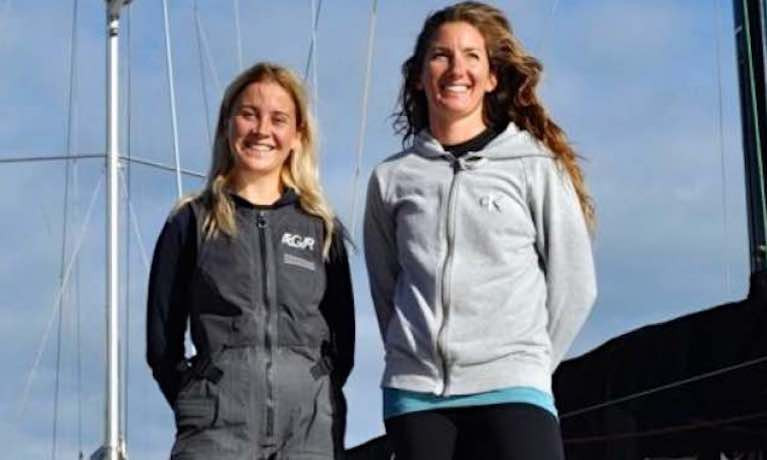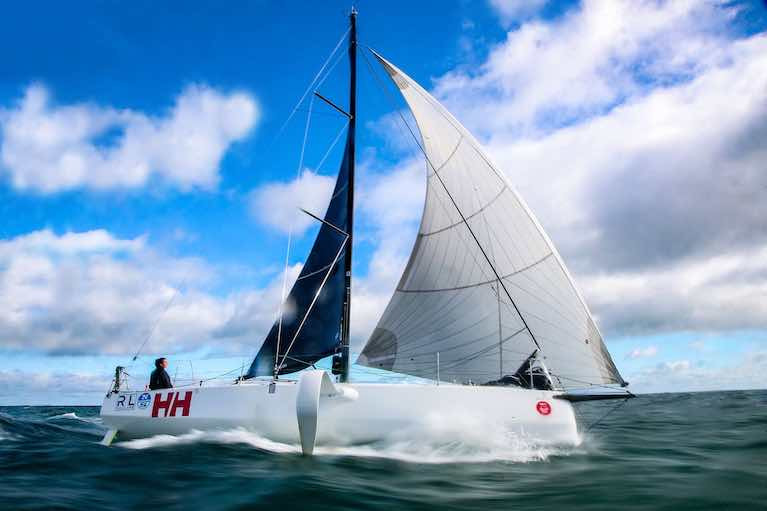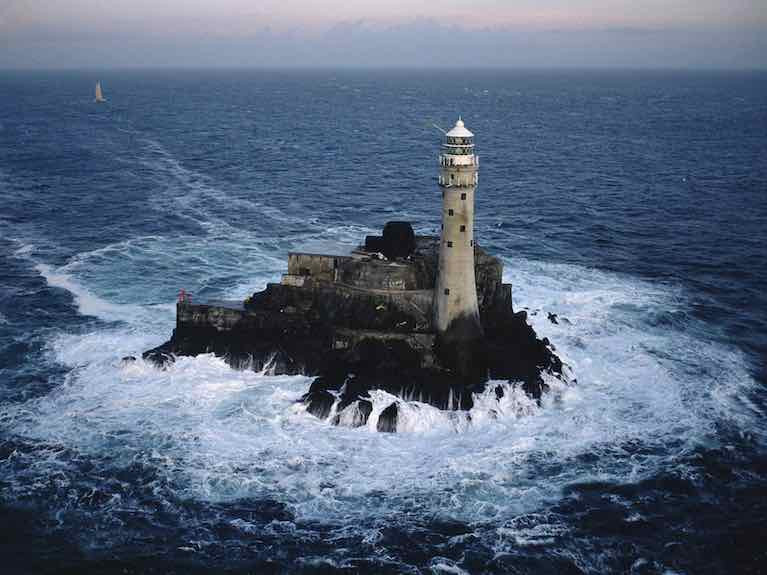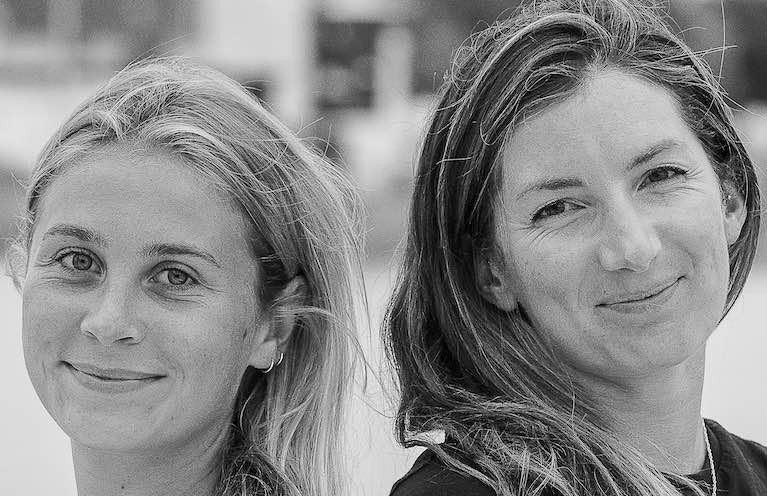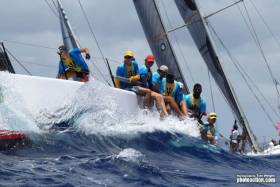Displaying items by tag: Pamela Lee
Pamela Lee & Catherine Hunt are "Sailors of the Month" for October
The new Round Ireland Two-handed Record Holders, RL Sailing's Pamela Lee of Greystones SC and Catherine Hunt, are acclaimed as October's "Sailors of the Month" after a superbly-executed circuit of our island home which went way beyond their initial challenge of establishing a significant speed for a female two-handed crew.
Their time of 3 days 19 hours and 45 minutes in the Figaro 3 Iarracht Maigeantata was not only many hours clear of previous comparable circuits by any crews of two-handed sailors, but was impressively close to record times set by fully-crewed larger boats - and it was all done so stylishly that this was sailing as performance art.
Read more on this record here
It's Pay-up Time for Iarracht Maigeanta in Tackling Headwinds & Strong Tides on Ireland's North Coast
Female Two-handed Round Ireland Record Day Three 2000hrs: When the going is good, the good get going - and they get going fast. This has been the mantra of Pam Lee and Cat Hunt, who brought their Beneteau Figaro 3 in past Tory Island and on to Ireland's North Coast at 1745 this evening (Thursday), just 34 hours after departing Dublin Bay with very focused use of favourable conditions in a clockwise circuit of Ireland, their mission being - as the Commissioner for Ireland for the World Sailing Speeds Record Committee has officially informed us today – the creation of "The Initial Women's Double-handed Around Ireland Record".
The semantics of it all can be resolved in the fullness of time. Right now, it's pay-up time. After hundreds of miles of favourable winds, they have the much more immediate problem of the southeasterly wind having a bit too much east in it, while lacking real oomph – the North Coast is proving to be hard work. Thus our hopes that they'd be just about able to lay Inishtrahull from Tory have been frustrated, as they're now hard on the wind and about 20 degrees below the required course. But at least the Figaro 3 is a performer, and at 1930hrs they were making 7.2 knots.
Regardless of its direction, so long as there's wind of some sort they can make progress, or can until they get into the seriously big tides east of Inishtrahull, and especially along and around Rathlin Island, which is not so much a tidal gate as more of a brutally uncompromising tidal drawbridge.
Sailing Magenta Round Ireland Tracker
East of Inishtrahull, it'll be a dead beat towards Rathlin, and as the tide will start running against them towards midnight, they may find it advantageous to tack inshore in slacker tides by Portrush, close past the spot where, in another life and about a million years ago, Shane Lowry was carving triumph for us all out of the Open Golf Championship.
Just as everyone was with Shane 15 months ago, so now the entire Irish sailing community is with the crew of Iarracht Maugeanta as the Date with Destiny at Rathlin draws nearer. Roughly speaking for the next two or three tides, the stream will be with them between 6 o'clock and 12 o'clock, so peak No-Go Time at Rathlin will be between one o'clock and 5 o'clock, regardless of day or night.
Admittedly the mighty tides at Rathlin are so weird that close in along the north cliffs, the stream is always running to the eastward. But to take advantage of that you have to be so close inshore that the cliffs play merry hell with the wind. One upon a time we were doing the Round Ireland Race in an ancient 83ft Maxi with a huge battered old mainsail which looked like it merited a tillage grant. With the ebb roaring outside, we were clawing along in daylight right inshore at Rathlin, and the cliff-nesting seabirds became so confused with this monster mainsail that some of them tried to alight on it. That's the kind of thing that happens racing past Rathlin - it's an otherworldly sort of place, not really part of Planet Earth at all.
The beating along the north coast by Iarracht Maigeanta was not unexpected, and with any luck when they finally get onto the northeast coast of Ireland, they may find themselves back on a beam reach and the knots buzzing merrily upwards. But for tonight, it's a case of known unknowns, and unknown unknowns. We wish them luck, and hope they close in on Rathlin through one of the favourable tidal windows.
Female Two-handed Round Ireland Record Day Three 0900hrs: At 0745 hours this morning, Pamela Lee and Catherine Hunt in the Beneteau Figaro 3 Iarracht Maigeanta had put County Mayo's northwest headlands of Eagle Island and Erris Head well astern, and were reaching across Donegal Bay towards their next major turning point of Tory Island off northwest Donegal in a moderate southeast breeze which provided reasonably smooth seas and steady progress.
Behind this deceptively humdrum progress report, there is a universe of achievement and competent campaigning. For 0745 hrs marked just two days into their circuit, which started from Dublin Bay on Tuesday morning. Yet by having the entire west coast of Connacht astern before those two days had elapsed, they were already well into the second half of their voyage.
Any boat sailing round Ireland from Dublin Bay in whatever direction reaches the halfway stage at Slyne Head off southwest Connemara, and in our signing-off report yesterday evening, we hoped they might be getting there near midnight. It was a qualified hope, as some forecasts were showing last night's cold calms over central Ireland spreading mistly over the Atlantic coast. But on the contrary, the coastal and offshore easterlies held up well, and while it was cold, progress was improving, and bang on time at midnight they were on the latitude of Slyne Head, though well at sea and sailing smoothly on course towards Achill at 8.8 knots.
Sailing Magenta Round Ireland Tracker
As they've reported to Shore Manager Kenneth Rumball, once they'd got north of the lumpier seas around the Blasket Islands yesterday, the steadier going enabled them to catch up on some sleep, but the uneven nature of the generally easterly wind's gradual progress of settling into being a steady breeze meant busy sail changes from time to time, yet they were still strengthening their mental and physical reserves for what looked like being a long cold night.
It was a cold night, but with the useful breeze on the beam and "the wind off the grass", the great headlands went past like clockwork, with Achill astern by 0330, and the dawn still barely hinting as Erris Head went by at 0615. Speeds were briefly reduced to 6.8 knots, but with the knots now up to 8.3 again as they make their way in a sou'easterly across towards Donegal at 0830 this morning, it's nicely on track.
Conditions are looking good for steady progress as far as Ireland's north point at Malin Head, as the course from Tory to the edge of the Malin and Inishtrahull outlying rocks is sufficiently north of east to continue to give them a leading wind. After Malin, it's a different sailing game entirely, as they're effectively into the beginnings of the North Channel's sailing problems of strong tides and frequent local wind variations all the way to the South Rock light off the County Down Coast.
It's always one of the trickiest stages. But as of now, with a real element of an easterly direction already being accommodated into their course to show they're homeward bound, the Pamela Hunt and Catherine Lee Two-Handed Round Ireland Challenge is going very well indeed.
Round Ireland Two-Handed Challenge Speeds West into the Night Towards the Fastnet Rock
Female Two-handed Round Ireland Record Day One 2000 hrs: The Round Ireland two-handed record challenge by Pamela Lee and Catherine Hunt, which started from the Kish in Dublin Bay at 0745 this morning, had been accelerating westward well out to sea off the East Cork coast, putting them due south of Capel Island at 1930hrs and making 12.5 knots. Their Beneteau Figaro 3 was beginning to feel the effects as the strong north to northeast winds - 25 knots and more in the Irish Sea and St George's Channel all afternoon - start spreading vigorously into the Atlantic.
Not that the Magenta team need more pressure power, as they've had a very handy favourable breeze all day. But through the early part of the night they've been having to handle this extra challenge of keeping up speed without sustaining any damage before the blast of extra wind has gone through, and at 1910hrs a problem arose and they peeled off for twenty minutes on a downwind course, but still sailing at 8.3 knots. Yet now (1940 hours) they're back up to 12.4 knots and it seems to be all systems go again.
Ironically, although they're on a record-establishing mission, they don't want to arrive down at the Fastnet Rock too early, as on the current setup, it gets very bumpy thereafter. From The Rock northwestwards, the wind has been more then fresh from the north along the Kerry and West Cork coasts through today, and as any Round Ireland and indeed Dun Laoghaire-Dingle Race veteran can affirm, slugging into a strong northerly off Kerry is no cakewalk.
But fortunately for the two co-skippers, the wind is expected to veer markedly and ease as it draws from the east, helping them round the corner and past Ireland's most westerly point, the unmarked Great Foze Rock west of the Blaskets, a lonely and mysterious place which is best avoided by night or day.
For now, however, that's in the future as supporters ashore wait to hear what caused the sudden alteration of course at 1910hrs, hoping that it was only a blip rather than the loss of an important sail or some rigging damage.
Sailing Magenta Round Ireland Record Tracker
New Start Line for Female Round Ireland Speed Sailing Record Bid
Offshore duo Pamela Lee and Cat Hunt who have announced an October bid to set a new Female Round Ireland sailing speed record now say the record run will start from the Kish Light and not as originally indicated off Wicklow.
Co-skipper Lee, says "we will actually be sailing the course set by the World Speed Sailing Record Council, which starts from a line off Kish lighthouse and can go either clockwise or anticlockwise – so not the Round Ireland Race route as originally specified", Lee told Afloat.
The record bid will be based out of Greystones Harbour in County Wicklow, Lee's home port.
 Record bidders: Cat Hunt and Pamela Lee on board the Figaro 3 at Greystones Harbour Marina this morning Photo: James Kirwan/BJ Marine
Record bidders: Cat Hunt and Pamela Lee on board the Figaro 3 at Greystones Harbour Marina this morning Photo: James Kirwan/BJ Marine
The countdown is now on and the pair could be making the record anytime after October 12.
As well as setting an inaugural female record the pair also want to have a stab at the Double Handed Round Ireland record along with breaking the outright monohull record and the under 40ft record, quite a record haul if achieved!
Greystones Sailing Club and Lough Derg Yacht Club member Pamela Lee is racing on TP52 'Conviction' as Bow at Antigua Race Week. Conviction leads class RSA3 with four wins from five races so far.
Lee has been racing as a bowman for the last few years around the world, including several Sydney to Hobart Races. Lee is eldest daughter of Norman Lee, the well known GP14 sailor.
The third day of racing at the 50th edition of Antigua Sailing Week was once again blessed with glorious conditions. Squally pewter skies cleared shortly after the first warning gun and the breeze slowly woke up as the skies cleared, touching 17 knots at times. Ten teams went out to the race course unbeaten, but only three returned with their perfect score intact after some intense racing; hotter than jerk chicken! The big boat CSA classes were treated to long windward leeward courses off the spectacular cliffs on the south coast of Antigua. The bareboats and smaller CSA classes raced in more sheltered conditions off Rendezvous Beach with short sharp legs testing boat handling skills and boat-on-boat tactics. Two races were held for the majority of the 150 yachts racing at Antigua Sailing Week.
A shuffle in the results today meant that the leaders have changed in several classes, but not amongst the undefeated teams: Peter Harrison's Sojana in CSA1, Ross Applebey's Scarlet Oyster in CSA 5 and Robert Szustkowski R-Six in Offshore Multihull. Race winners today included Kialoa III; Conviction; Rebel-B, Dingo; Perseverare Diabolicum; Spirit (Antigua National Sailing Academy); L'Esperance and Hightide.
The closest race today was Race 4 in CSA 4. Mark Chapman's Trini Ker 11.3, Dingo was the winner by just 5 seconds from Ian Hope-Ross' St. Maarten team racing Melges 32, Kick 'em Jenny 2. Dingo now leads the class with Douglas Ayres' American J/122, Team Skylark/El Ocaso in second, just a point ahead of Sergio Sagramoso's Puerto Rican Melges 32, Lazy Dog.
"We got holed on the first day and the whole team stayed up on the first night to get us back in the game," said Dingo's Mark Chapman. "Today we really clicked together and we had great boat speed which is a real weapon in a close class. After the terrible first day we are just delighted, but this regatta is far from over."
In CSA 7, Sir Bobby Velasquez's St. Maarten team racing First 45, L'Esperance had a perfect day on the water scoring straight bullets to lead the class after five races; just half a point ahead of their long-time rivals, also from St. Maarten; Byerley & Ferron's J/39, Micron 99 Lord Jim.
"We had a problem with our propeller folding on the first day and we went round the wrong mark on the second day, so we didn't have the best of starts to the regatta," explained Sir Bobby Velasquez. "The racing today could not have gone better as we made some good decisions that worked out well. However, the regatta is only half over."
In CSA 8, the class lead has changed hands every day. Steve Carson's Dehler 33, Hightide is the latest yacht to wear the bullseye, posting two wins today to open up a five point lead at the top of the class from Geoffrey Pidduck's Modified 6 Metre, Biwi Magic and Tanner Jones' J/30, Caribbean Alliance Insurance.
"Four of the boats in the class race together in Antigua on a regular basis, so it is no surprise to me that we are so closely matched and we know each other's strengths and weaknesses. Today it was our turn to get the upper hand, but it is never over until the fat lady sings," says Carson.
Tonight is the big entertainment night at the 50th edition of Antigua Sailing Week. Internationally-acclaimed reggae artiste, Damian "Jr. Gong" Marley, the youngest son of Bob Marley is set to headline the eighth edition of Reggae in the Park, live in Nelson's Dockyard. Over 4,000 party-goers are expecting a phenomenal performance from the Grammy award-winning artist when he takes the stage.
Tomorrow, Wednesday 3rd May is President Lay Day Beach Party featuring the Nonsuch Bay RS Elite Challenge. Eight teams will race for the top prize of a week's all-inclusive accommodation for two people in a deluxe suite at the fantastic Nonsuch Bay Resort. The ultimate Caribbean beach party kicks off at Pigeon Point Beach at midday. The grills fire up from noon with top entertainment from DJs, live music and some crazy beach games.




























